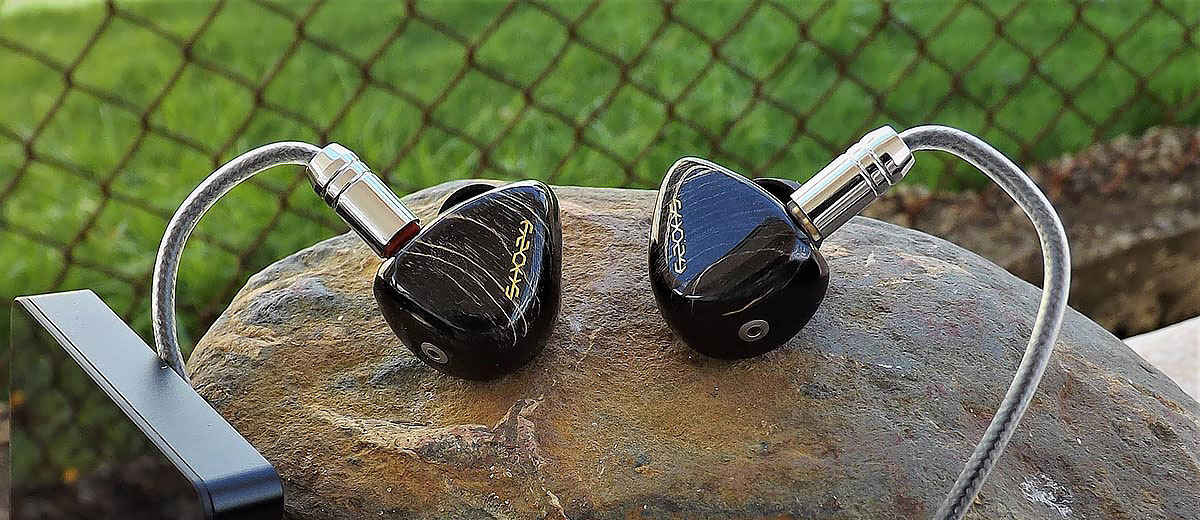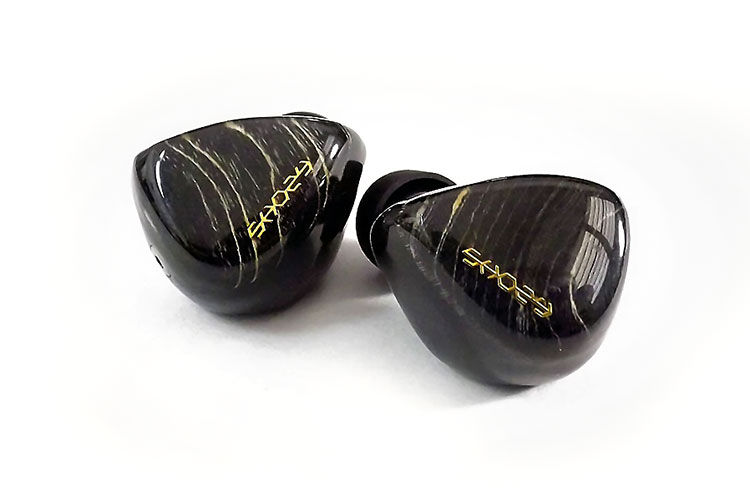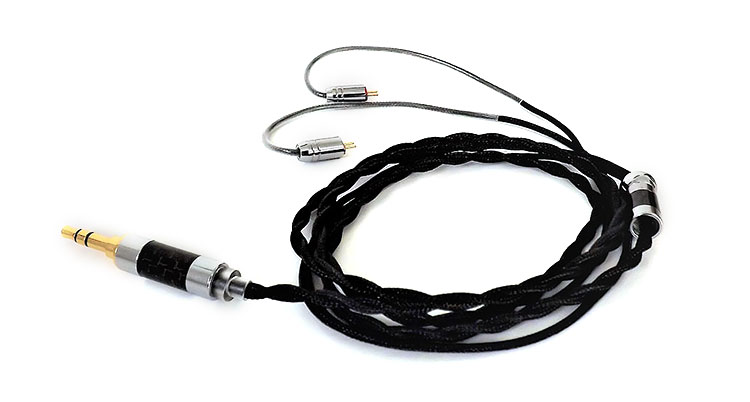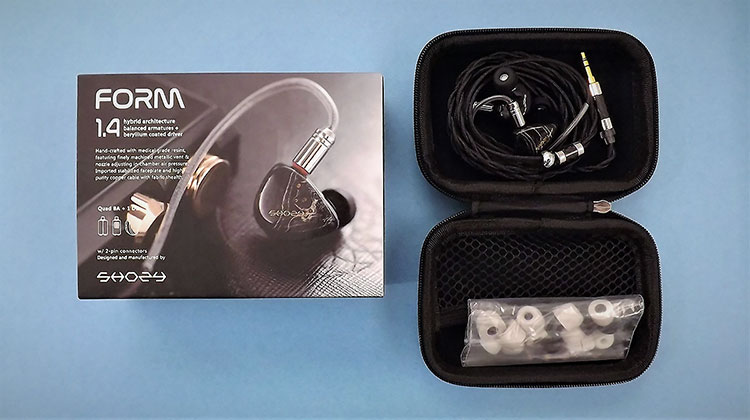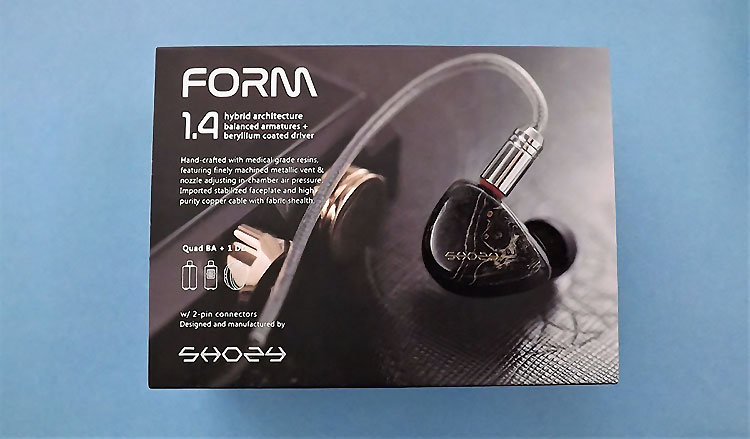The Shozy Form 1.4 is a universal hybrid 5 driver IEM featuring a single 9.2mm beryllium-coated dynamic driver and 4 BA drivers. It is priced at $200.
Disclaimer: The Shozy Form 1.4 sent to us is a sample in exchange for our honest opinion in this review. We thank the team at Shozy for giving us this opportunity.
To read more about Shozy products we reviewed on Headfonics click here.
Note, this review follows our new scoring guidelines for 2020 which you can read up on here.
Not enough people know that Shozy makes many products and not just one or two IEMs. If you go to their website you will find that they make many IEMs, a special edition portable amplifier and they even make a DAP.
Their Shozy Form 1.1 IEM got some attention amongst the IEM fans. Some said they had too much bass and some said they were great for their price bracket.
I personally like a small bass tilt in sound signature but some companies do go overboard. Shozy is not one of those companies and they aim for a pretty flat frequency response curve but with a touch of color.
Perhaps a couple of other Shozy items are popular. However, none have made it to the public eye so far like the Shozy Form 1.4. The Shozy Form 1.4 is a Hybrid five driver IEM with a composite shell.
Design
The Shozy Form 1.4 is composed of a 3D printed shell with a faceplate and based on the Shozy Form 1.1 design. The outer shell is made of a high-grade resin. I have sensitive skin and these do not bother me or irritate my ears whatsoever. I could wear them for hours.
The other section is the faceplate which is handcrafted from stabilized wood. This is where the difference is between the 1.1 and the 1.4 models besides the driver configuration and the chamber system. Each one produced is unique and no two are the same.
Both pieces are hand-assembled seamlessly and you cannot see where each piece meets the other. They are assembled, clear coated, and then polished for a seamless look. I could tell a lot of work went into these shells.
The Shozy name/logo is gorgeously set in a gold inlay under the clear coat finish. I wonder if its real gold? It certainly looks like real gold to me.
Metallic Bass Vent
IEM porting is popular and essential I would say. The Shozy Form 1.4 has a metal vent and not just a hole somewhere. I am glad metal vents are becoming more common. I think they have a certain appeal and look good if properly done.
Metal vents ensure consistency in bass more than just a hole. I imagine it also makes it easier to tune the bass response.
Sort of like building speaker boxes. Once you know the driver specifications you make the cabinet accordingly and then you just calculate the vent size and length. Only I can imagine that this is done on an almost micro level for IEMs.
Not only is the bass vent made of metal but the output nozzle is also metal and has a common sized diameter. It seems to be the T200 type with a diameter of around 4.2mm.
Driver Configuration
The Form 1.4 has a total of five drivers. All of the drivers used are custom made. Shozy borrowed the chamber design from the Form 1.1 but made this one a Quad design and installed each driver in a separate chamber except for the dynamic driver.
The dynamic driver separately takes advantage of that metal bass port. The 9.2mm Berillium coated driver handles the bass notes. The rest of the spectrum is handled by 4 Balanced Armature drivers.
All the drivers are matched before assembly. According to Shozy, the best materials are also used to assemble the Form 1.4 internally. Wire, solder, and any other component or materials used are carefully chosen.
Each unit is fitted with a three-way crossover. Quality plus consistency is assured by testing each set after assembly using Analog Precision and Bruel and Kjaer testing rigs before being shipped.
Stock Cable
I have seen this two-tone tip before. I have about five IEMs here at least that have that same 3.5mm plug. The important thing is that it does employ good quality, is made of metal and it seems extremely sturdy. It is Shozy branded.
Even the .78mm male plugs look familiar. But again using a battle-tested plug is not a bad thing at all. My preference after all is the .78mm being used here and not the MMCX type. It just has better contact with less resistance and there is no spin. Red and white tips are used to mark right and left connectors.
The wires themselves are a cloth-wrapped twisted pair of high purity copper wires that come to a small metal cylinder that matches the 3.5mm plug. At the Y split, the wires used are a pair of single cloth wrapped wires.
The cable itself is pretty good. It always remains straight, has good flexibility, is resistant to kinking and I do not hear any major microphonics from this wire. A metal bead is used for Y length adjustment. This one is a keeper.
Comfort & Isolation
The Shozy Form 1.4 isolates very well passively using the included flanges. I had trouble hearing the outside world and there is no bleed either. Comfort was also very good. Once I put these in they resisted to come out. The angle of the flange makes these stay in place pretty well.
In other words, you could do physical activity with them on and they will not fall out easily. Would I take them to the gym? I would not want to sweat down those quad chambers and do not wanna scatch them up either. I would rather use them for serious listening sessions.
Packaging & Accessories
We received the retail version. The well-laminated box contains another box that slides out. Inside the second box is a carrying pouch that is cloth-covered and zipper lined.
Again the carrying pouch is very familiar to me. Not in a bad way though. I do prefer a carrying pouch over a bag any day. The contents of the pouch are the two IEMS, the wire, and a small bag containing all the flanges.
In the small bag, you will find a total of nine sets of flanges. You get three pairs which are made of black rubber, three pairs made of white silicon, and the other three pairs are foam flanges which are my favorite.
Shozy Form 1.4 Sound Impressions
The Shozy Form 1.4 has a listed frequency response of 20 to 20k with a sensitivity rating of 100 decibels. Listed impedance is 19 ohms.
Shozy is aiming for a fatigue-less tuning and say so in their literature. The general audio presentation of the Form 1.4 to me is slightly warm with a smoothness through the frequency spectrum. Nothing jumps out at you as a big spike or peak however it is not a flat signature and there is some color.
The frequency graph line to me would look like a bass tilt but slightly higher in the midbass than the sub frequencies and then slightly tilting down to the highs with the midrange at the middle point in output.
I listened to these for at least 2 weeks before making a judgment and made sure they were well broken in.
Bass
Bass response is what I call full-bodied with an emphasis in the midbass of about 3 or 4 decibels. My ears sensed that the sub-bass drops below 35Hz. The sub-bass is not missing, it is there however the bottom octave is slightly recessed compared to the midbass.
I hear a rise in the bass at about 60 Hz to about 150 Hz and then it slowly dips making these seem midbass forward.
The bass has decent speed and tonality. Bass notes are distinct but if I had to complain of one thing is that there is an artificiality or bloom in the upper bass region that slightly negatively affects the sound quality.
The bass has a decent amount of impact. I tried the Form 1.4 with Call Of Duty on PC and there were scary moments because of the intensity of the bass so I would say its a very competitive driver when it comes to delivering a punch.
Midrange
The midrange presentation is medium-bodied and a few decibels pushed back. It has a soft character and remains flat except for a peak at around 5kHz. The 5kHz peak is audible however it should not bother sensitive ears. It just gives the midrange a bit of presence which is needed in this set.
There are a couple of other dips and peaks but nothing important or even worth mentioning. The midrange has good tonality and nothing seems out of place in pitch. The midrange tone is pretty soft and nonoffensive. It has a very relaxed presentation.
Treble
The Shozy form 1.4 has clean highs but drop very early in the frequency response curve. They do have good clarity and some shimmer. There are frequency response curves printed online of the Form 1.4 and the Form 1.1 in a comparison of the two and they almost look identical. This was my first observation, the similarities.
My second observation is that the graph shows a huge drop after about 7kHz and all the way down to 15kHz and at that point there is another rise. At 15kHz the difference in the output is at least a 15-decibel drop from 7kHz.
The highs are there but the dip causes most of the highs to be recessed. There is a benefit to this. When performing they do not sound harsh at all.
Imaging & Soundstage
The Shozy Form 1.4 to me has a medium width soundstage. They are not super wide but do have some width, height, and some depth. They can even rear project on occasions.
The imaging is very precise and can place instruments in their corresponding place. Left to right sound production is very accurate.
Synergy
Lots of people will look at the specifications on the Shozy Form 1.4 and make a misjudgment.
I say this because their listed efficiency is 100 decibels and combined with an impedance of 19 ohms, these on paper seem pretty efficient. They are efficient but I needed to turn up the volume louder than normal for an acceptable volume level compared to others with similar specs.
The funny aspect of this is that no matter what you use them with, whether it be a phone or a desktop amplifier with more power, this character remains.
They do scale well with a better amplifier but not by much. But these will work acceptably with everything you might have and do not need special amplification or high power.
Selective Comparison
Tri I3
I like to compare recently reviewed IEMs because I still have their sound impressions fresh in thought. The prices are close to each other with one at 167 USD and the other at 199. Both are a hybrid driver configuration IEM.
If you like midrange the I3 wins. The Planar Magnetic driver shines in that aspect and is my favorite type of driver.
The I3 has strong bass and midrange. They are aggressive and work great on hard-hitting tracks and are party animals but they can also be delicate and smooth but al lower volume levels.
However, if you want a relaxing experience I would suggest trying them out first. Why? Because of their aggressiveness, they can hurt you if you have sensitive ears or are a person with Tinnitus. Some might even find them fatiguing.
Our Verdict
Who would the Shozy Form 1.4 appeal to? Let us go through the positive points checklist.
A smooth character with a non-fatiguing sound, A good fit with a shell that has a unique artisan touch. A decent wire that does not need to be replaced for a better wire. Decent flanges and a carrying pouch.
These are for people who want a relaxing sound signature and are bothered by sharp highs, a shouting midrange, and just wanna laid back and relaxing sound. People with Tinnitus could enjoy these or people who find other IEMs fatiguing.
Are there any negatives? The positive aspects outweigh them tenfold and although these are in a very competitive price bracket, they are a good buy if the above is what you are looking for in an IEM.
Shozy Form 1.4 Specifications
- Driver 4 balanced armatures, 1 dynamic driver
- Cavity Imported medical resin (3D printed)
- Faceplate Imported wood stabilized panel
- Technology 3-way crossover
- Sensitivity 102 dB
- Frequency 20 Hz – 20KHz
- Impedance 16Ω
- Cable 2-pin 0.78 mm
- Connector 3.5 mm

